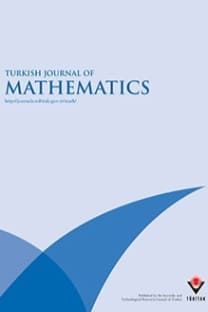The Meyer function on the handlebody group
The Meyer function on the handlebody group
___
- [1] Ashikaga T, Endo H. Various aspects of degenerate families of Riemann surfaces. Sugaku Expositions 2006; 19 (2): 171-196.
- [2] Atiyah MF. The logarithm of the Dedekind η -function. Mathematische Annalen 1987; 278: 335-380. doi: 10.1007/BF01458075
- [3] Birman JS. On the equivalence of Heegaard splittings of closed, orientable 3-manifolds. In: Neuwirth LP (editor). Knots, groups, and 3-manifolds (Papers dedicated to the memory of R. H. Fox), Annals of Mathematics Studies 84. Princeton, NJ, USA: Princeton University Press, 1975, pp. 137-164.
- [4] Endo H. Meyer’s signature cocycle and hyperelliptic fibrations. Mathematische Annalen 2000; 316 (2): 237-257. doi: 10.1007/s002080050012
- [5] Gilmer PM, Masbaum G. Maslov index, lagrangians, mapping class groups and TQFT. Forum Mathematicum 2013; 25 (5): 1067-1106. doi: 10.1515/form.2011.143
- [6] Harer J. The second homology group of the mapping class group of an orientable surface. Inventiones Mathematicae 1983; 72: 221-239. doi: 10.1007/BF01389321
- [7] Harer J. The third homology group of the moduli space of curves. Duke Mathematical Journal 1991; 63 (1): 25-55. doi:10.1215/S0012-7094-91-06302-7
- [8] Hilden HM. Generators for two groups related to the braid group. Pacific Journal of Mathematics 1975; 59 (2): 475-486. doi: 10.2140/pjm.1975.59.475
- [9] Hirose S. The action of the handlebody group on the first homology group of the surface. Kyungpook Mathematical Journal 2006; 46: 399-408.
- [10] Hirose S, Kin E. The asymptotic behavior of the minimal pseudo-Anosov dilatations in the hyperelliptic handlebody groups. The Quarterly Journal of Mathematics 2017; 68: 1035-1069. doi: 10.1093/qmath/hax012
- [11] Iida S. Adiabatic limits of η -invariants and the Meyer functions. Mathematische Annalen 2010; 346: 669-717. doi: 10.1007/s00208-009-0412-y
- [12] Ishida T, Sato M. A twisted first homology group of the handlebody mapping class group. Osaka Journal of Mathematics 2017; 54: 587-619. doi: 10.18910/667001
- [13] Kawazumi N. Canonical 2-forms on the moduli space of Riemann surfaces. In: Papadopoulos A (editor). Handbook of Teichmüller theory Volume II. Zürich, Switzerland: European Mathematical Society Publishing House, 2009, pp. 217-237.
- [14] Kuno Y. Meyer functions and the signature of fibered 4-manifolds. In: Papadopoulos A (editor). Handbook of Teichmüller theory Volume V. Zürich, Switzerland: European Mathematical Society Publishing House, 2016, pp. 75- 96.
- [15] Matsumoto Y. Lefschetz fibrations of genus two—a topological approach. In: Kojima S, Matsumoto Y, Saito K, Seppälä M (editor). Topology and Teichmüller Spaces, Proceedings of the 37th Taniguchi Symposium. Singapore: World Scientific, 1996, pp. 123-148.
- [16] Meyer W. Die Signatur von lokalen Koeffizientensystemen und Faserbündeln. Bonner Mathematische Schriften 1972; 53: 1-59 (in German).
- [17] Meyer W. Die Signatur von Flächenbündeln. Mathematische Annalen 1973; 201 (3): 239-264 (in German). doi: 10.1007/BF01427946
- [18] Morifuji T. On Meyer’s function of hyperelliptic mapping class groups. Journal of the Mathematical Society of Japan 2003; 55 (1): 117-129. doi:10.2969/jmsj/1196890845
- [19] Sakasai T. Lagrangian mapping class groups from a group homological point of view. Algebraic & Geometric Topology 2012; 12: 267-291. doi:10.2140/agt.2012.12.267
- [20] Turaev VG. First symplectic Chern class and Maslov indices. Journal of Soviet Mathematics 1987; 37: 1115-1127. doi: 10.1007/BF01086635
- [21] Wajnryb B. Mapping class group of a handlebody. Fundamenta Mathematicae 1998; 158: 195-228. doi: 10.4064/fm158-3-195-228
- ISSN: 1300-0098
- Yayın Aralığı: 6
- Yayıncı: TÜBİTAK
On symplectic 8-manifolds admitting Spin(7)-structure
Some characterizations of KB-operators on Banach lattices and ordered Banach spaces
Characterizations of dual curves and dual focal curves in dual Lorentzian space D3 1
Sareh MEHDIZADEH GILANI, Yusuf YAYLI, Nemat ABAZARI
On Hausdorff-Young inequalities in generalized Lebesgue spaces
The generalized inverses of the products of two elements in a ring
Application of spectral mapping method to Dirac operator
On the chromatic polynomial and the domination number of k-Fibonacci cubes
Elif SAYGI, Zülfükar SAYGI, Ömer EĞECİOĞLU
On X -Gorenstein projective dimensions and precovers
Some results on top generalized local cohomology modules with respect to a system of ideals
